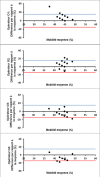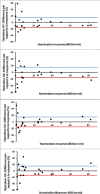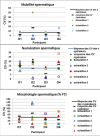[Inter-and intra-operator variability in the analysis of semen parameters: results from a quality control program]
- PMID: 28292078
- PMCID: PMC5325489
- DOI: 10.11604/pamj.2016.25.115.9158
[Inter-and intra-operator variability in the analysis of semen parameters: results from a quality control program]
Abstract
Introduction: Semen analysis is a key part of male infertility investigation. The necessity of quality management implementation in the andrology laboratory has been recognized in order to ensure the reliability of its results. The aim of this study was to evaluate intra- and inter-individual variability in the assessment of semen parameters in our laboratory through a quality control programme.
Methods: Four participants from the laboratory with different experience levels have participated in this study. Semen samples of varying quality were assessed for sperm motility, concentration and morphology and the results were used to evaluate inter-participant variability. In addition, replicates of each semen sample were analyzed to determine intra-individual variability for semen parameters analysis.
Results: The average values of inter-participant coefficients of variation for sperm motility, concentration and morphology were 12.8%, 19.8% and 48.9% respectively. The mean intra-participant coefficients of variation were, respectively, 6.9%, 12.3% and 42.7% for sperm motility, concentration and morphology. Despite some random errors of under- or overestimation, the overall results remained within the limits of acceptability for all participants. Sperm morphology assessment was particularly influenced by the participant's level of experience.
Conclusion: The present data emphasize the need for appropriate training of the laboratory staff and for regular participation in internal quality control programmes in order to improve the reliability of laboratory results.
Introduction: L’analyse du sperme est d’une importance majeure dans l’exploration de l'infertilité masculine. Afin de s’assurer de la fiabilité des résultats rendus, l’implantation du management de qualité en spermiologie est devenue une nécessité.Le but de ce travail a été d’évaluer la variabilité intra- et inter-opérateurau cours de l’analyse des paramètres spermatiques au sein de notre laboratoire de spermiologie, à travers la mise en place d’un programme de contrôle de qualité.
Méthodes: Quatre opérateurs ayant des niveaux d’expérience différents ont participé à l’étude. La variabilité inter-individuelle des résultats des lectures de la mobilité, la concentration et la morphologie spermatique a été évaluée sur plusieurs échantillons de sperme de qualités différentes. Pour chaque paramètre spermatique, la variabilité intra-individuelle a été évaluée en analysant les résultats des lectures de plusieurs aliquotes issus de chacun des échantillons utilisés.
Résultats: Les coefficients de variation moyens inter-opérateurs ont été de12.8%, 19.8% et 48.9% pour la mobilité, la concentration et la morphologie spermatique, respectivement. Les coefficients de variation moyens intra-opérateurs ont été de6.9%, 12.3%et 42.7% pour la mobilité, la concentration, et la morphologie spermatique, respectivement. Mis à part quelques écarts (erreurs aléatoires), la plupart des mesures réalisées ont été dans les limites d’acceptabilité pour l’ensemble des opérateurs.La variabilité de l’évaluation morphologique des spermatozoïdes a été particulièrement influencée par le niveau d’expérience de l’opérateur.
Conclusion: Les résultats de cette étude mettent l’accent sur la nécessité d’une formation adéquate du personnel de laboratoire, et de la participation régulière aux contrôles de qualité internes afin de minimiser les divergences et d’améliorer la fiabilité des résultats.
Keywords: Internal quality control; concentration; morphology; motility; semen analysis.
Conflict of interest statement
Les auteurs ne déclarent aucun conflit d’intérêt.
Figures




References
-
- World Health Organization. WHO Laboratory Manual for the Examination of Human Semen and Sperm–Cervical Mucus Interaction. 3rd ed. Cambridge University Press; 1992. p. 107.
-
- World Health Organization. WHO Laboratory Manual for the Examination of Human Semen and Sperm-Cervical Mucus Interaction. 4th ed. Cambridge: Cambridge University Press; 1999.
-
- World Health Organization. WHO Laboratory Manual for the Examination and Processing of Human Semen. 5th ed. Geneva: World Health Organization; 2010.
-
- Keel BA, Stembridge TW, Pineda G, Serafy NT., Sr Lack of Standardization in Performance of the Semen Analysis among Laboratories in the United States. Fertil Steril. 2002 Sep;78(3):603–8. - PubMed
MeSH terms
LinkOut - more resources
Full Text Sources
Other Literature Sources
